Rear latch PONTIAC VIBE 2005 Owners Manual
[x] Cancel search | Manufacturer: PONTIAC, Model Year: 2005, Model line: VIBE, Model: PONTIAC VIBE 2005Pages: 374, PDF Size: 2.49 MB
Page 7 of 374
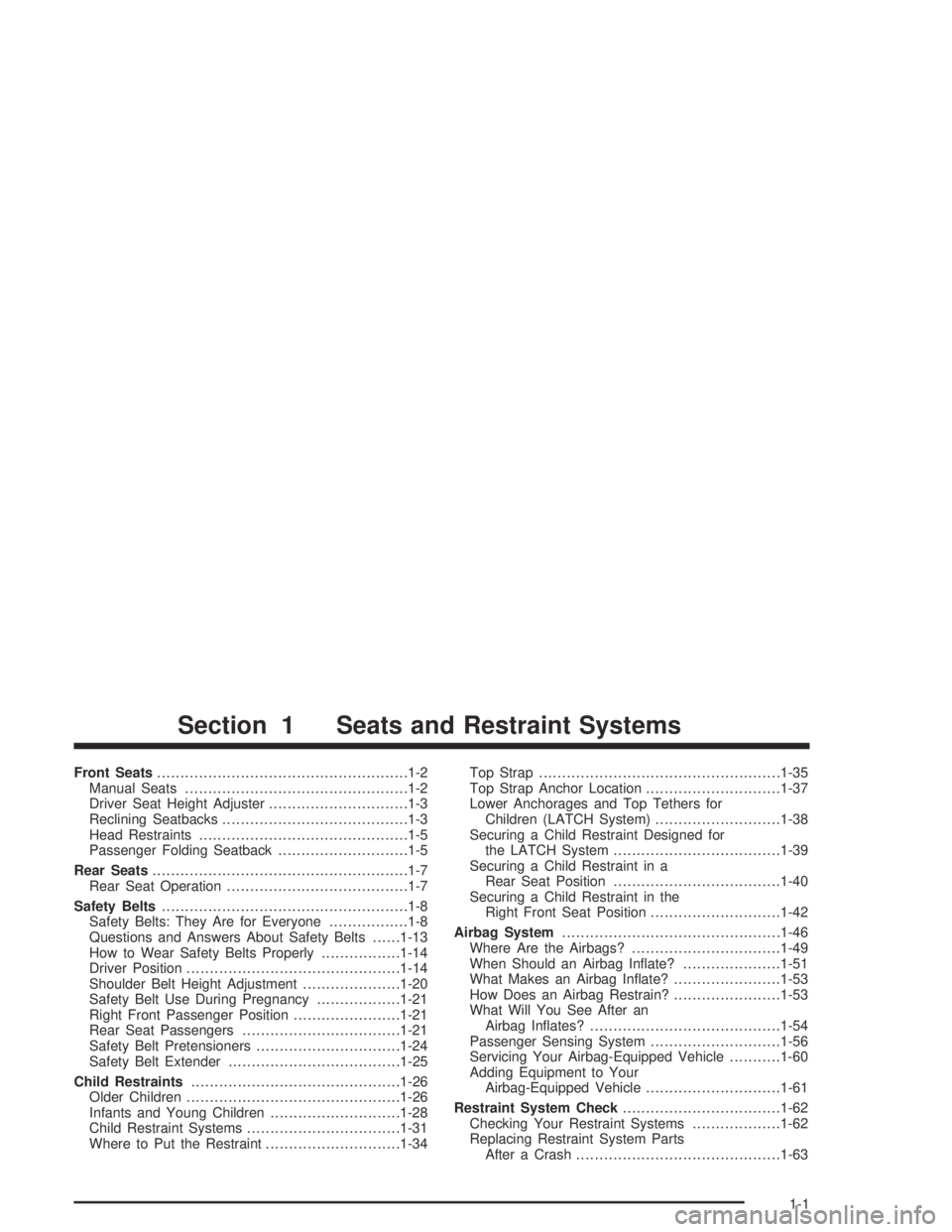
Front Seats......................................................1-2
Manual Seats................................................1-2
Driver Seat Height Adjuster..............................1-3
Reclining Seatbacks........................................1-3
Head Restraints.............................................1-5
Passenger Folding Seatback............................1-5
Rear Seats.......................................................1-7
Rear Seat Operation.......................................1-7
Safety Belts.....................................................1-8
Safety Belts: They Are for Everyone.................1-8
Questions and Answers About Safety Belts......1-13
How to Wear Safety Belts Properly.................1-14
Driver Position..............................................1-14
Shoulder Belt Height Adjustment.....................1-20
Safety Belt Use During Pregnancy..................1-21
Right Front Passenger Position.......................1-21
Rear Seat Passengers..................................1-21
Safety Belt Pretensioners...............................1-24
Safety Belt Extender.....................................1-25
Child Restraints.............................................1-26
Older Children..............................................1-26
Infants and Young Children............................1-28
Child Restraint Systems.................................1-31
Where to Put the Restraint.............................1-34Top Strap....................................................1-35
Top Strap Anchor Location.............................1-37
Lower Anchorages and Top Tethers for
Children (LATCH System)...........................1-38
Securing a Child Restraint Designed for
the LATCH System....................................1-39
Securing a Child Restraint in a
Rear Seat Position....................................1-40
Securing a Child Restraint in the
Right Front Seat Position............................1-42
Airbag System...............................................1-46
Where Are the Airbags?................................1-49
When Should an Airbag In�ate?.....................1-51
What Makes an Airbag In�ate?.......................1-53
How Does an Airbag Restrain?.......................1-53
What Will You See After an
Airbag In�ates?.........................................1-54
Passenger Sensing System............................1-56
Servicing Your Airbag-Equipped Vehicle...........1-60
Adding Equipment to Your
Airbag-Equipped Vehicle.............................1-61
Restraint System Check..................................1-62
Checking Your Restraint Systems...................1-62
Replacing Restraint System Parts
After a Crash............................................1-63
Section 1 Seats and Restraint Systems
1-1
Page 28 of 374

Lap-Shoulder Belt
All rear seating positions have lap-shoulder belts.
Here is how to wear one properly.
1. Pick up the latch plate and pull the belt across you.
Do not let it get twisted.
The shoulder belt may lock if you pull the belt
across you very quickly. If this happens, let the belt
go back slightly to unlock it. Then pull the belt
across you more slowly.2. Push the latch plate into the buckle until it clicks.
Pull up on the latch plate to make sure it is secure.
If the buckle does not click, check to be sure
that you are using the correct buckle. The buckle
for the center rear passenger position has the word
CENTER on it.
When the shoulder belt is pulled out all the way, it
will lock. If it does, let it go back all the way
and start again.
If the belt is not long enough, seeSafety Belt
Extender on page 1-25.
Make sure the release button on the buckle is
positioned so you would be able to unbuckle the
safety belt quickly if you ever had to.
1-22
Page 40 of 374
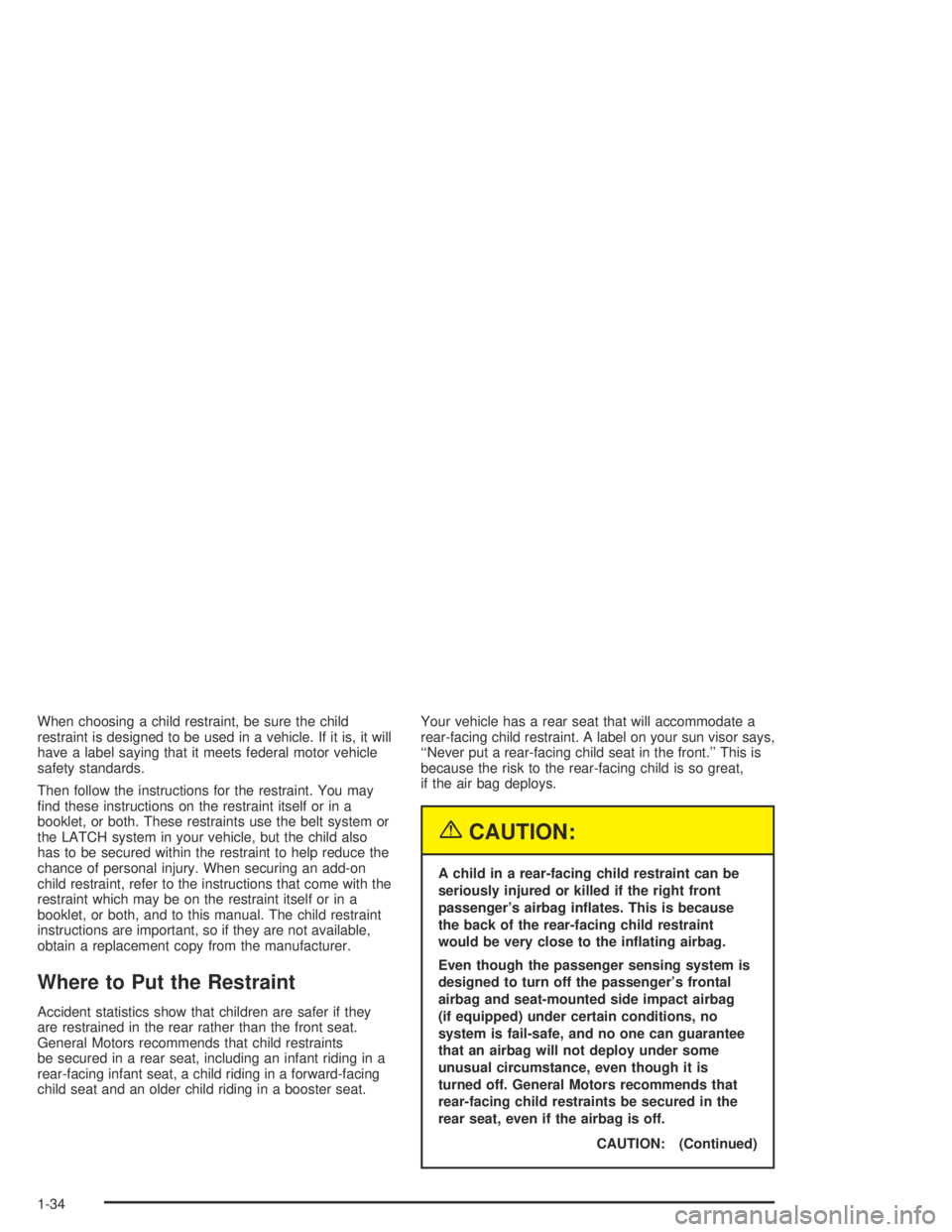
When choosing a child restraint, be sure the child
restraint is designed to be used in a vehicle. If it is, it will
have a label saying that it meets federal motor vehicle
safety standards.
Then follow the instructions for the restraint. You may
�nd these instructions on the restraint itself or in a
booklet, or both. These restraints use the belt system or
the LATCH system in your vehicle, but the child also
has to be secured within the restraint to help reduce the
chance of personal injury. When securing an add-on
child restraint, refer to the instructions that come with the
restraint which may be on the restraint itself or in a
booklet, or both, and to this manual. The child restraint
instructions are important, so if they are not available,
obtain a replacement copy from the manufacturer.
Where to Put the Restraint
Accident statistics show that children are safer if they
are restrained in the rear rather than the front seat.
General Motors recommends that child restraints
be secured in a rear seat, including an infant riding in a
rear-facing infant seat, a child riding in a forward-facing
child seat and an older child riding in a booster seat.Your vehicle has a rear seat that will accommodate a
rear-facing child restraint. A label on your sun visor says,
‘‘Never put a rear-facing child seat in the front.’’ This is
because the risk to the rear-facing child is so great,
if the air bag deploys.
{CAUTION:
A child in a rear-facing child restraint can be
seriously injured or killed if the right front
passenger’s airbag in�ates. This is because
the back of the rear-facing child restraint
would be very close to the in�ating airbag.
Even though the passenger sensing system is
designed to turn off the passenger’s frontal
airbag and seat-mounted side impact airbag
(if equipped) under certain conditions, no
system is fail-safe, and no one can guarantee
that an airbag will not deploy under some
unusual circumstance, even though it is
turned off. General Motors recommends that
rear-facing child restraints be secured in the
rear seat, even if the airbag is off.
CAUTION: (Continued)
1-34
Page 44 of 374

Lower Anchorages and Top Tethers
for Children (LATCH System)
Your vehicle has the LATCH system. You will �nd
anchors for the outside rear seat positions.
This system, designed to make installation of child
restraints easier, does not use the vehicle’s safety belts.
Instead, it uses vehicle anchors and child restraint
attachments to secure the restraints. Some restraints
also use another vehicle anchor to secure a top
tether strap.
A. Lower Anchorage
B. Lower AnchorageC. Top TetherA. Lower Anchorage
B. Lower Anchorage
In order to use the LATCH system in your vehicle,
you need a child restraint designed for that system.
1-38
Page 46 of 374
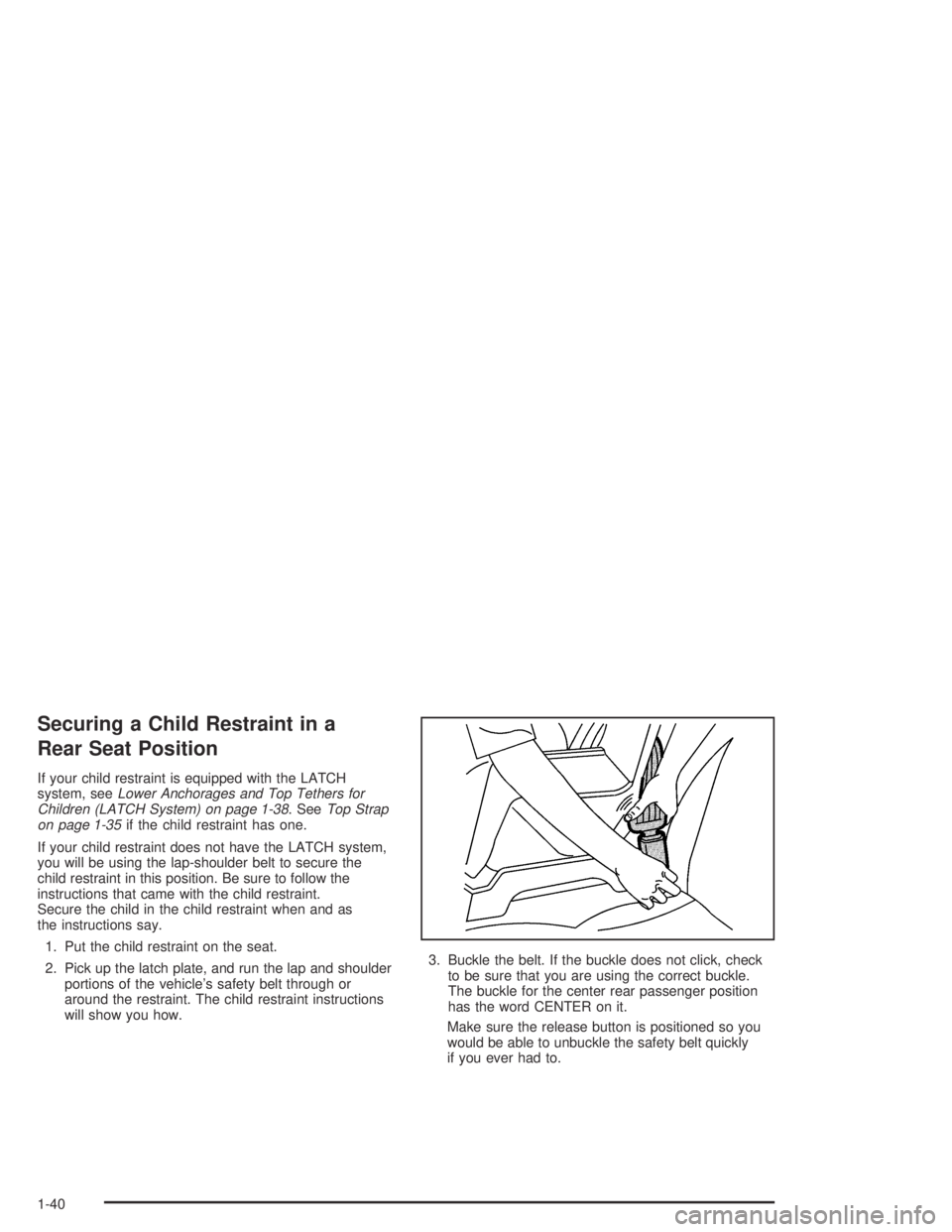
Securing a Child Restraint in a
Rear Seat Position
If your child restraint is equipped with the LATCH
system, seeLower Anchorages and Top Tethers for
Children (LATCH System) on page 1-38. SeeTop Strap
on page 1-35if the child restraint has one.
If your child restraint does not have the LATCH system,
you will be using the lap-shoulder belt to secure the
child restraint in this position. Be sure to follow the
instructions that came with the child restraint.
Secure the child in the child restraint when and as
the instructions say.
1. Put the child restraint on the seat.
2. Pick up the latch plate, and run the lap and shoulder
portions of the vehicle’s safety belt through or
around the restraint. The child restraint instructions
will show you how.3. Buckle the belt. If the buckle does not click, check
to be sure that you are using the correct buckle.
The buckle for the center rear passenger position
has the word CENTER on it.
Make sure the release button is positioned so you
would be able to unbuckle the safety belt quickly
if you ever had to.
1-40
Page 49 of 374
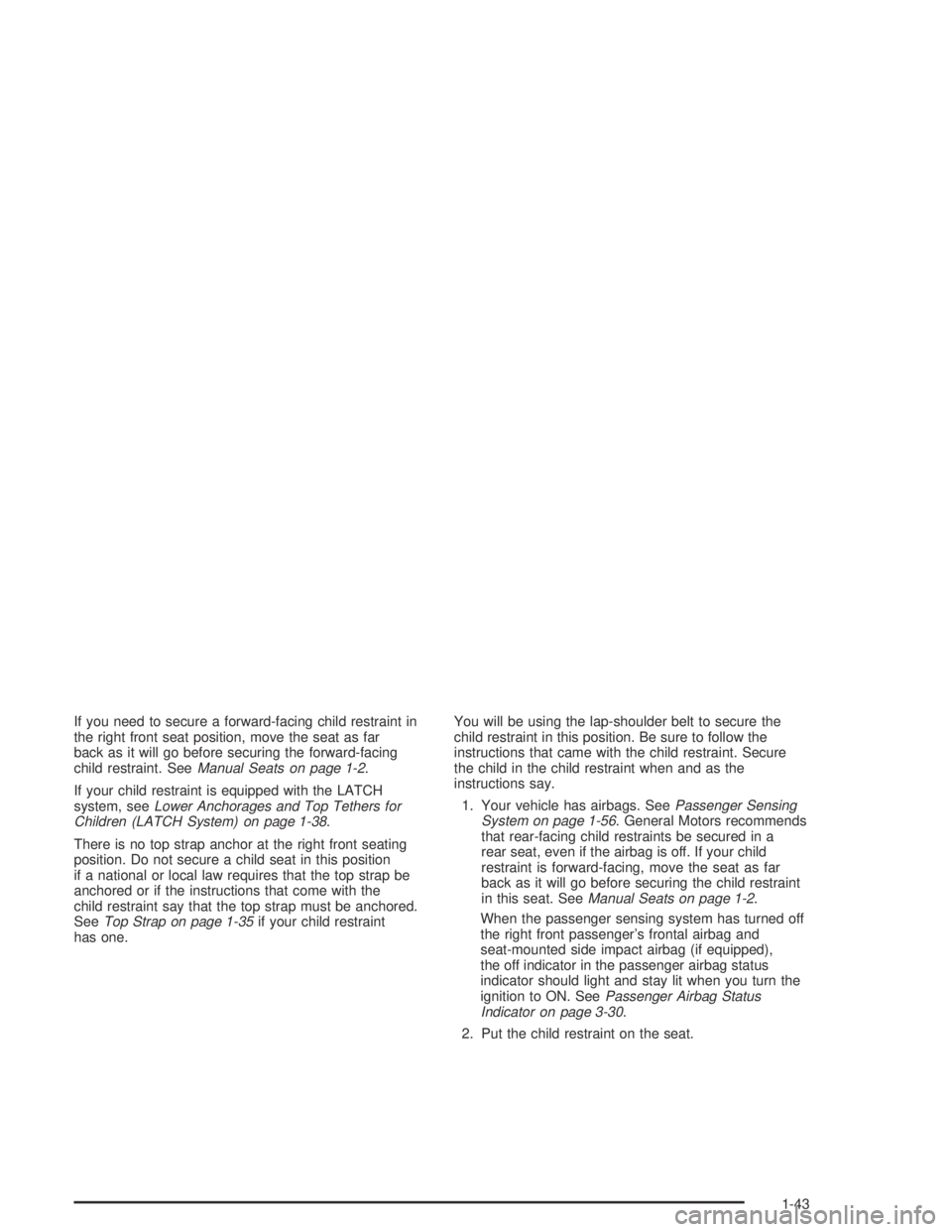
If you need to secure a forward-facing child restraint in
the right front seat position, move the seat as far
back as it will go before securing the forward-facing
child restraint. SeeManual Seats on page 1-2.
If your child restraint is equipped with the LATCH
system, seeLower Anchorages and Top Tethers for
Children (LATCH System) on page 1-38.
There is no top strap anchor at the right front seating
position. Do not secure a child seat in this position
if a national or local law requires that the top strap be
anchored or if the instructions that come with the
child restraint say that the top strap must be anchored.
SeeTop Strap on page 1-35if your child restraint
has one.You will be using the lap-shoulder belt to secure the
child restraint in this position. Be sure to follow the
instructions that came with the child restraint. Secure
the child in the child restraint when and as the
instructions say.
1. Your vehicle has airbags. SeePassenger Sensing
System on page 1-56. General Motors recommends
that rear-facing child restraints be secured in a
rear seat, even if the airbag is off. If your child
restraint is forward-facing, move the seat as far
back as it will go before securing the child restraint
in this seat. SeeManual Seats on page 1-2.
When the passenger sensing system has turned off
the right front passenger’s frontal airbag and
seat-mounted side impact airbag (if equipped),
the off indicator in the passenger airbag status
indicator should light and stay lit when you turn the
ignition to ON. SeePassenger Airbag Status
Indicator on page 3-30.
2. Put the child restraint on the seat.
1-43
Page 64 of 374
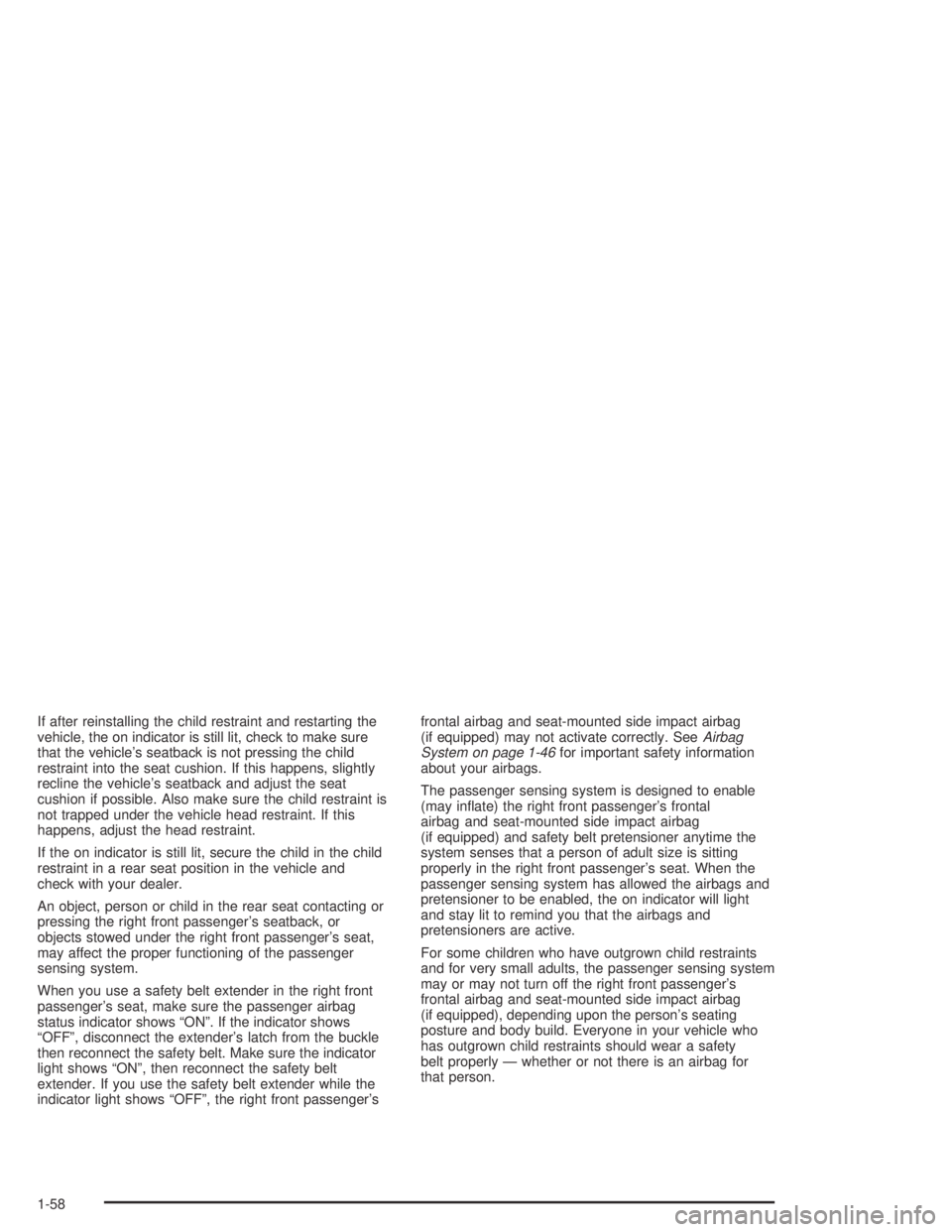
If after reinstalling the child restraint and restarting the
vehicle, the on indicator is still lit, check to make sure
that the vehicle’s seatback is not pressing the child
restraint into the seat cushion. If this happens, slightly
recline the vehicle’s seatback and adjust the seat
cushion if possible. Also make sure the child restraint is
not trapped under the vehicle head restraint. If this
happens, adjust the head restraint.
If the on indicator is still lit, secure the child in the child
restraint in a rear seat position in the vehicle and
check with your dealer.
An object, person or child in the rear seat contacting or
pressing the right front passenger’s seatback, or
objects stowed under the right front passenger’s seat,
may affect the proper functioning of the passenger
sensing system.
When you use a safety belt extender in the right front
passenger’s seat, make sure the passenger airbag
status indicator shows “ON”. If the indicator shows
“OFF”, disconnect the extender’s latch from the buckle
then reconnect the safety belt. Make sure the indicator
light shows “ON”, then reconnect the safety belt
extender. If you use the safety belt extender while the
indicator light shows “OFF”, the right front passenger’sfrontal airbag and seat-mounted side impact airbag
(if equipped) may not activate correctly. SeeAirbag
System on page 1-46for important safety information
about your airbags.
The passenger sensing system is designed to enable
(may in�ate) the right front passenger’s frontal
airbag and seat-mounted side impact airbag
(if equipped) and safety belt pretensioner anytime the
system senses that a person of adult size is sitting
properly in the right front passenger’s seat. When the
passenger sensing system has allowed the airbags and
pretensioner to be enabled, the on indicator will light
and stay lit to remind you that the airbags and
pretensioners are active.
For some children who have outgrown child restraints
and for very small adults, the passenger sensing system
may or may not turn off the right front passenger’s
frontal airbag and seat-mounted side impact airbag
(if equipped), depending upon the person’s seating
posture and body build. Everyone in your vehicle who
has outgrown child restraints should wear a safety
belt properly — whether or not there is an airbag for
that person.
1-58
Page 75 of 374
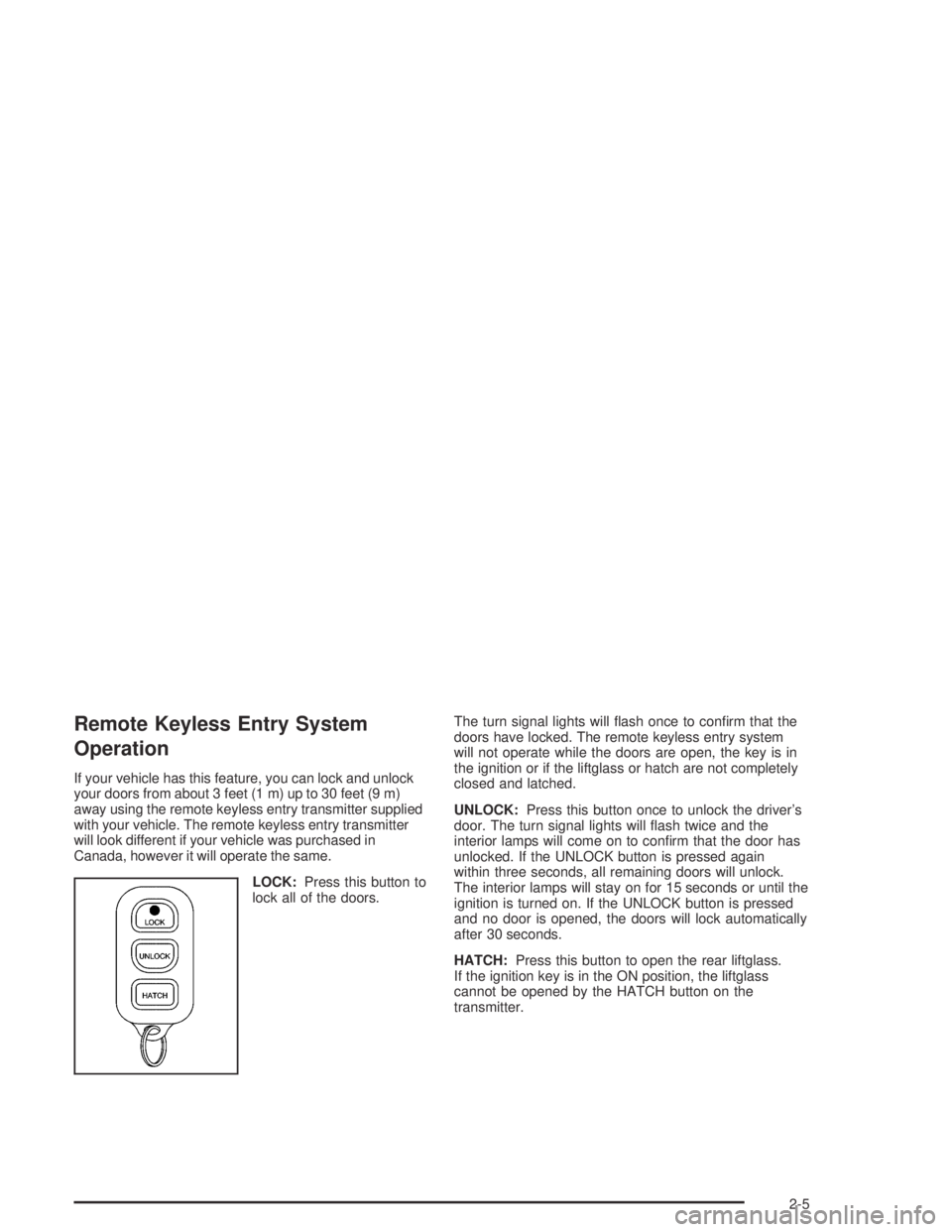
Remote Keyless Entry System
Operation
If your vehicle has this feature, you can lock and unlock
your doors from about 3 feet (1 m) up to 30 feet (9 m)
away using the remote keyless entry transmitter supplied
with your vehicle. The remote keyless entry transmitter
will look different if your vehicle was purchased in
Canada, however it will operate the same.
LOCK:Press this button to
lock all of the doors.The turn signal lights will �ash once to con�rm that the
doors have locked. The remote keyless entry system
will not operate while the doors are open, the key is in
the ignition or if the liftglass or hatch are not completely
closed and latched.
UNLOCK:Press this button once to unlock the driver’s
door. The turn signal lights will �ash twice and the
interior lamps will come on to con�rm that the door has
unlocked. If the UNLOCK button is pressed again
within three seconds, all remaining doors will unlock.
The interior lamps will stay on for 15 seconds or until the
ignition is turned on. If the UNLOCK button is pressed
and no door is opened, the doors will lock automatically
after 30 seconds.
HATCH:Press this button to open the rear liftglass.
If the ignition key is in the ON position, the liftglass
cannot be opened by the HATCH button on the
transmitter.
2-5
Page 338 of 374
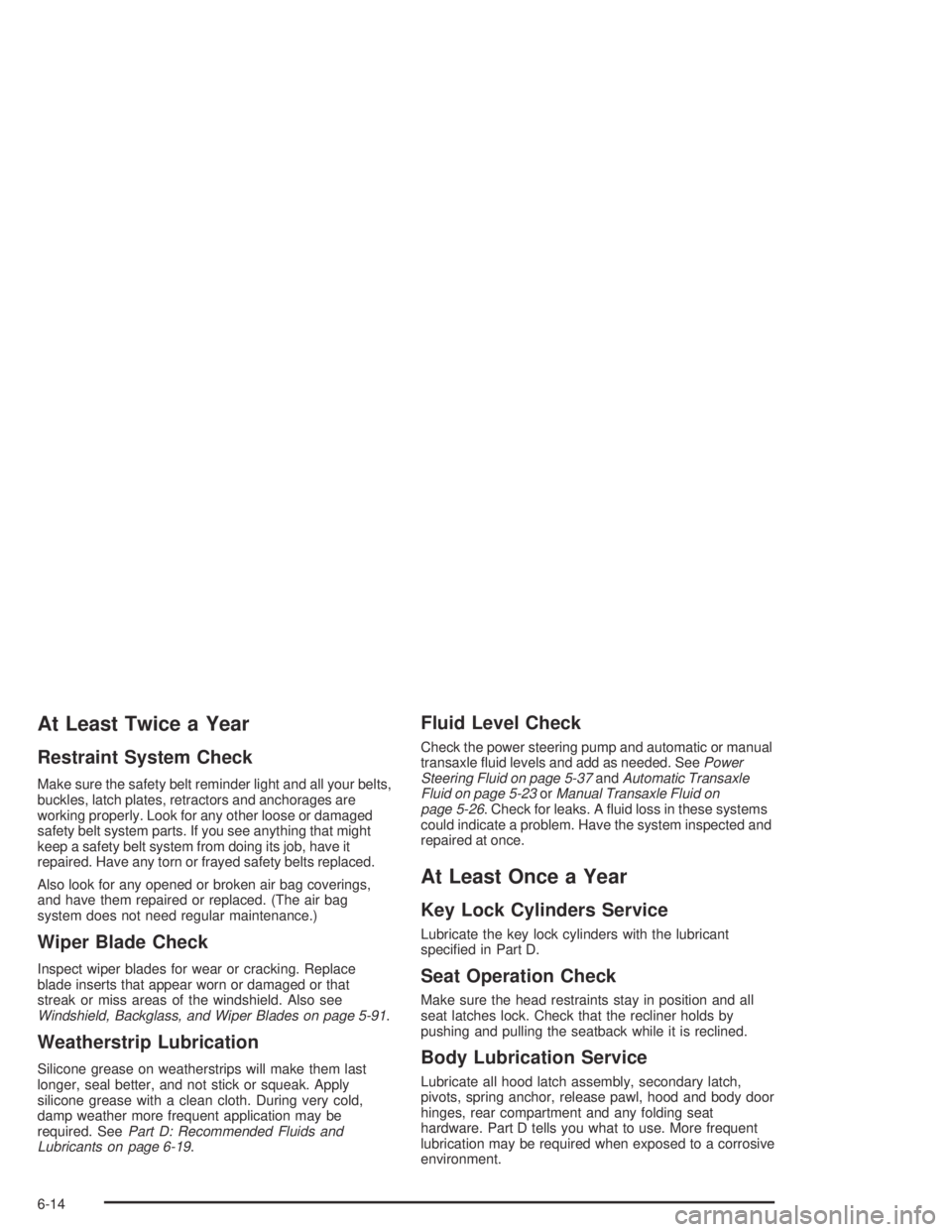
At Least Twice a Year
Restraint System Check
Make sure the safety belt reminder light and all your belts,
buckles, latch plates, retractors and anchorages are
working properly. Look for any other loose or damaged
safety belt system parts. If you see anything that might
keep a safety belt system from doing its job, have it
repaired. Have any torn or frayed safety belts replaced.
Also look for any opened or broken air bag coverings,
and have them repaired or replaced. (The air bag
system does not need regular maintenance.)
Wiper Blade Check
Inspect wiper blades for wear or cracking. Replace
blade inserts that appear worn or damaged or that
streak or miss areas of the windshield. Also see
Windshield, Backglass, and Wiper Blades on page 5-91.
Weatherstrip Lubrication
Silicone grease on weatherstrips will make them last
longer, seal better, and not stick or squeak. Apply
silicone grease with a clean cloth. During very cold,
damp weather more frequent application may be
required. SeePart D: Recommended Fluids and
Lubricants on page 6-19.
Fluid Level Check
Check the power steering pump and automatic or manual
transaxle �uid levels and add as needed. SeePower
Steering Fluid on page 5-37andAutomatic Transaxle
Fluid on page 5-23orManual Transaxle Fluid on
page 5-26. Check for leaks. A �uid loss in these systems
could indicate a problem. Have the system inspected and
repaired at once.
At Least Once a Year
Key Lock Cylinders Service
Lubricate the key lock cylinders with the lubricant
speci�ed in Part D.
Seat Operation Check
Make sure the head restraints stay in position and all
seat latches lock. Check that the recliner holds by
pushing and pulling the seatback while it is reclined.
Body Lubrication Service
Lubricate all hood latch assembly, secondary latch,
pivots, spring anchor, release pawl, hood and body door
hinges, rear compartment and any folding seat
hardware. Part D tells you what to use. More frequent
lubrication may be required when exposed to a corrosive
environment.
6-14
Page 344 of 374
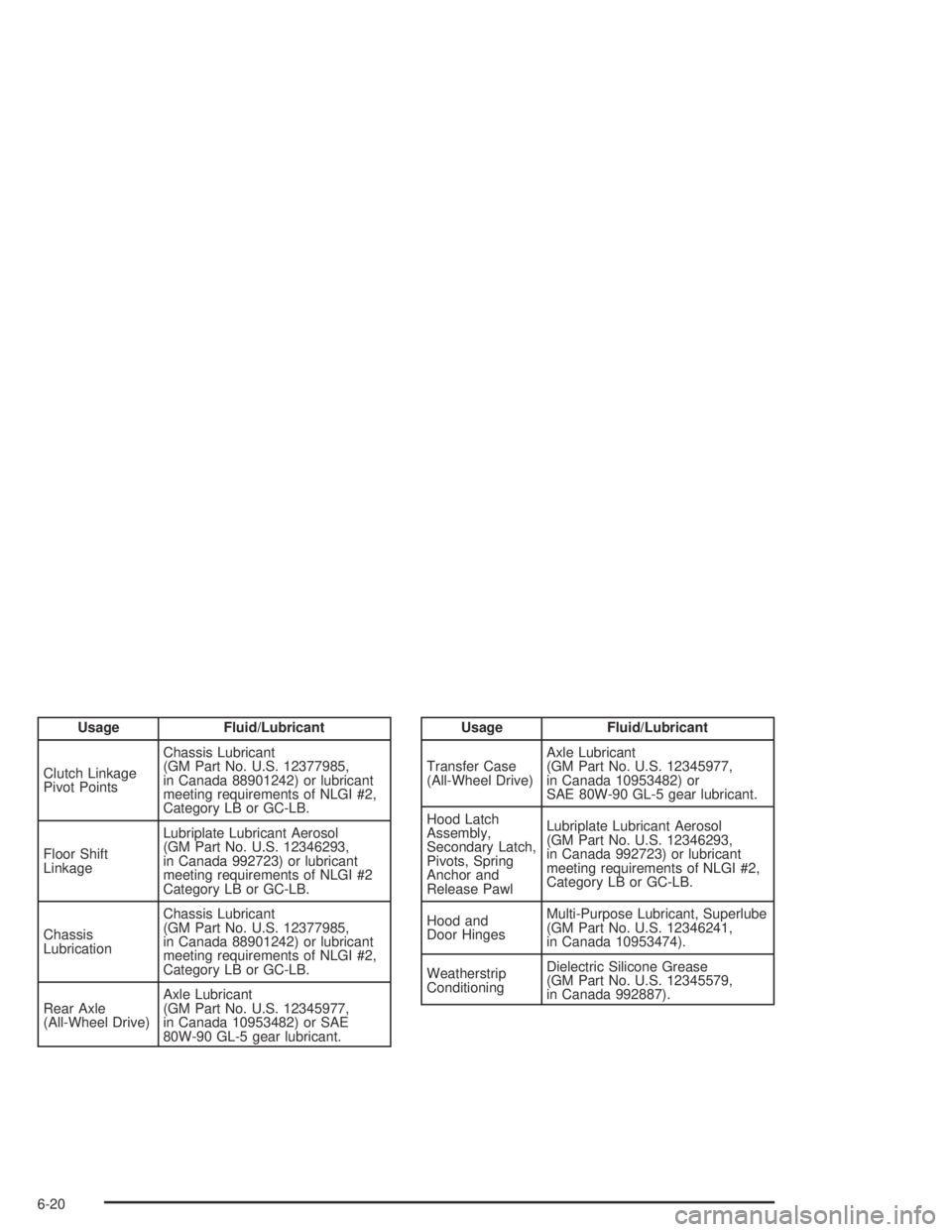
Usage Fluid/Lubricant
Clutch Linkage
Pivot PointsChassis Lubricant
(GM Part No. U.S. 12377985,
in Canada 88901242) or lubricant
meeting requirements of NLGI #2,
Category LB or GC-LB.
Floor Shift
LinkageLubriplate Lubricant Aerosol
(GM Part No. U.S. 12346293,
in Canada 992723) or lubricant
meeting requirements of NLGI #2
Category LB or GC-LB.
Chassis
LubricationChassis Lubricant
(GM Part No. U.S. 12377985,
in Canada 88901242) or lubricant
meeting requirements of NLGI #2,
Category LB or GC-LB.
Rear Axle
(All-Wheel Drive)Axle Lubricant
(GM Part No. U.S. 12345977,
in Canada 10953482) or SAE
80W-90 GL-5 gear lubricant.Usage Fluid/Lubricant
Transfer Case
(All-Wheel Drive)Axle Lubricant
(GM Part No. U.S. 12345977,
in Canada 10953482) or
SAE 80W-90 GL-5 gear lubricant.
Hood Latch
Assembly,
Secondary Latch,
Pivots, Spring
Anchor and
Release PawlLubriplate Lubricant Aerosol
(GM Part No. U.S. 12346293,
in Canada 992723) or lubricant
meeting requirements of NLGI #2,
Category LB or GC-LB.
Hood and
Door HingesMulti-Purpose Lubricant, Superlube
(GM Part No. U.S. 12346241,
in Canada 10953474).
Weatherstrip
ConditioningDielectric Silicone Grease
(GM Part No. U.S. 12345579,
in Canada 992887).
6-20